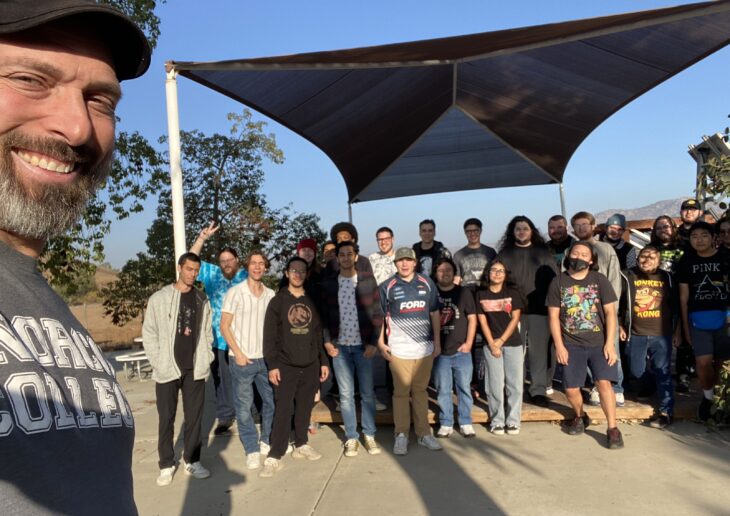
Culinary careers are sizzling again as the hospitality and restaurant industry bounces back from the pandemic and seeks to fill the positions vacated during the COVID-19 downturn. Chaffey College is doing its part to get more cooks in the kitchen.

With the $455 billion video game market expected to grow to $665.77 billion by 2030 (Fortune Business Insights), opportunities abound for students who want to create awesome gameplay experiences for gamers worldwide, and Norco College is a prime destination for those who want to take on the challenge.
“This program is for anyone with the passion to create— not just play— games,” says Jeff Clendenning (Photo: above, left), Assistant Professor of Game Art at Norco College. “It’s for those who want to go from being entertained to creating the experiences that entertain others.”
Although other community colleges offer programs focused on specific game development skills— Chaffey College, for example, offers a Computer Game Development Certificate— Norco offers an associate degree and is the only community college in Southern California offering a comprehensive program covering the major specialties in the field.
“Our Game Development program is built to give students a comprehensive, hands-on introduction to the four major areas of game development: Art, Design, Programming, and Production,” Clendenning says. “This foundation allows students to explore various disciplines and understand what it really takes to create games— an often challenging but incredibly rewarding process.”
Students can earn a certificate by completing the Core requirements plus 6 units in their chosen focus area. Associates degrees can be earned by completing the certificate requirements plus general education courses. Students can also complete requirements for transfer to a four-year institution. Here are the programs:
Norco’s programs provide a strong general foundation in C++, preparing students for engineering roles across the field. Yet, more than just technical skills are emphasized. According to Clendenning, students gain professional workflows, industry-standard practices, and essential soft skills such as teamwork, communication, and time management— qualities that are critical for success in this collaborative industry. Students also build portfolios that help them transfer to a university without the prohibitive educational costs of starting at a four-year institution. For those who do want to continue their education, institutions such as the Laguna College of Art and Design, Art Center College of Design, UC Irvine, USC, and others in Southern California offer excellent options.
The college enjoys a prime location at the gateway between the Inland Empire and numerous potential employers in Orange County, including major game studios such as Blizzard, Obsidian, Turtle Rock, InExile, and more. It’s also only about 50 miles from Los Angeles, home to some of the most prestigious game studios in the country.
“This proximity allows students to leverage networking opportunities while gaining a high-quality, affordable education,” Clendenning says.
Experienced faculty with real-world game industry experience is another advantage. Two program instructors co-own a third-party development studio that recently released Marvel Puzzle Quest. Clendenning himself brings more than 15 years of experience in Triple-A game development as a concept artist, lighting artist, art director, and technical director, contributing to projects such as StarCraft and Fallout at studios like EA, Activision, Blizzard, Konami, Obsidian, and more.
And with his successful career in the industry, Clendenning knows a thing or two about how to succeed in the field.
“Creativity, curiosity, perseverance, and a willingness to learn are the keys to success,” he says. “The only limits are the ones you place on yourself.”
Indeed, the opportunities seem to have few limits. The Bureau of Labor Statistics (BLS) projects a 16% increase in video game designer positions between 2022 and 2032. More than 32,000 job vacancies are expected to be filled through 2029. And the pay is good, too. The average salary for an entry-level game developer is $108,471 (ZipRecruiter) and $139,000 for the field as a whole (BLS).
Career options for students who get a degree in game development include game developer, background artist, game programmer, audio engineer, concept artist, character artist/animator, content designer, and computer programmer.
Clendenning can rattle off the names of numerous program alumni who have worked in some of the most prestigious game studios in the country on some of the best-known games in the world.
But even with all of its success, the program has plans to be even better. Upgrades are in the works for the program’s facilities with plans for virtual reality, augmented reality, and motion capture spaces. Additionally, a high-quality virtual PC solution is being developed to provide students access to industry-level hardware and software on their PCs.
New experiential learning opportunities are being explored, inspired by the growth of the Game Development Club (GDC), where students work in small “strike teams” to create multiplayer levels from concept to completion.
“Our GDC teams have published titles under their belt before graduation. These projects mimic real-world production environments, teaching students teamwork, iterative design, and problem-solving,” Clendenning says. “Our plan is to integrate these prototyped ideas explored through the club into the curriculum as a practicum or lab component.”
Clendenning is proud that Norco’s Game Development program develops more than just game-building skills.
“Our Game Development program and Game Development Club fosters collaboration, socialization, and teamwork, helping even our most introverted students build confidence. These interactions prepare students not just for their careers but for life, creating a network of lifelong friendships and opportunities.”

Culinary careers are sizzling again as the hospitality and restaurant industry bounces back from the pandemic and seeks to fill the positions vacated during the COVID-19 downturn. Chaffey College is doing its part to get more cooks in the kitchen.

Dual Enrollment (DE) is catching on as students and their families recognize the advantages of earning college credit while still working towards high school graduation. But students aren’t the only… Read More – Good News for Community Colleges: Dual Enrollments Are on the Rise

Enrollment in courses not offering credit toward a degree or certificate are outpacing for-credit programs in some states (Fed Communities). And it’s no wonder. With the convenience, minimal time commitment,… Read More – No Credit, No Problem: Noncredit Courses Gain Steam